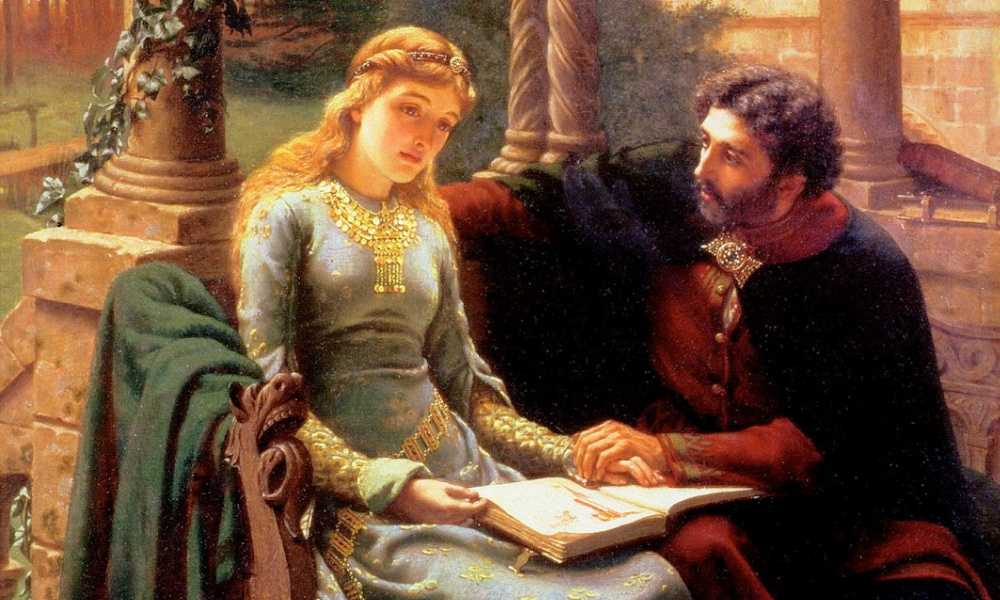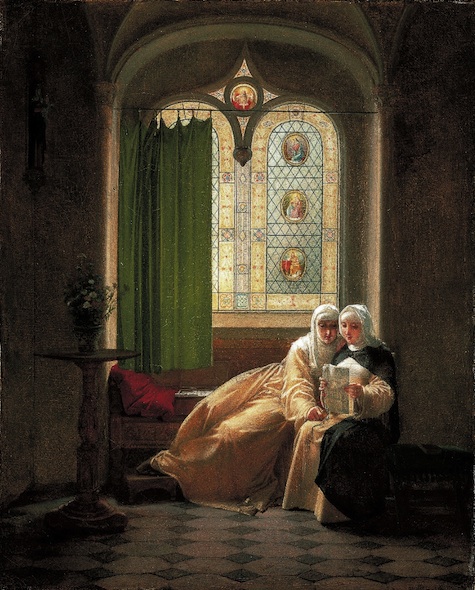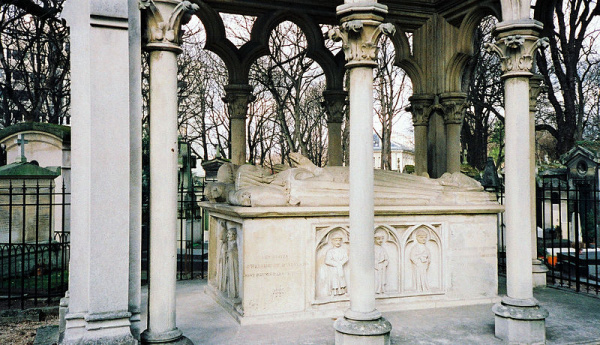A legendary love story: Abelard and Héloïse
A legendary love story: Abelard and Héloïse
A legendary love story: Abelard and Héloïse
-
Hannah
-
Hannah

Abelard and his Pupil Heloise by Edmund Leighton (source)
Héloïse was a brilliant scholar of Latin, Greek and Hebrew. Her wide knowledge and intelligence made her nominatissima, ‘most renowned’, in Western Europe. Young scholars require tutelage, and so it was that in 1115, as a young woman (some say as young as seventeen, others argue she was in her early twenties), Héloïse came to be a student of the well-respected Parisian teacher and philosopher Pierre Abelard.
It was a meeting of brilliant and bright minds, and the two quickly fell deeply in love. Abelard convinced Héloïse’s uncle and guardian, Fulbert, to let him move into their home, where he would tutor Héloïse. A passionate, but illicit, affair began, the culmination of which was Héloïse falling pregnant. She was whisked away to Brittany to stay with her sister for her confinement, and once the baby – a son named Astrolabe – was born, she returned to Paris.
Fulbert, understandably, was enraged upon discovering the affair, and to appease him Abelard proposed marriage to Héloïse, but a secret marriage, for he worried the move would affect his prosperous career. Secrets have a way of getting out, however, and in this case Fulbert was the perpetrator: he began telling people of the ‘secret’ marriage.
Indiscretions were not tolerated in the 12th century, and the repercussions were grave: ultimately, a group of Fulbert’s friends attacked Abelard one night and castrated him. Full of shame, Abelard turned to the monkhood, donning his robes at the Abbey of St Denis in Paris. The heartbroken Héloïse, meanwhile, took the vows of sisterhood as a nun – reluctantly, it must be said, although she accepted her fate, becoming prioress, eventually, at the Oratory of the Paraclete in Champagne.

Heloise at the Abbey of the Paraclete by Jean-Baptiste Mallet (source)
You may be wondering, what makes this love story endure? So far it has been no more than a thwarted illicit affair. It is what comes next that has made the story of Abelard and Héloïse go down in history: the two lovers began a correspondence by letter that has stood the test of time – passionate and intelligent debate captured forever in ink and paper.
These are not mere love letters, however, for the story of Abelard and Héloïse is, ultimately, a tragic one. Abelard repudiates their love, their relationship, recasting it as sinful lust and directing Héloïse to turn away from him, to God. Poor Héloïse! Modern-day academics have suggested that Abelard’s harsh, somewhat arrogant take on their relationship at this point may in fact be a deliberate attempt by Abelard to protect Héloïse. In his book Abelard & Heloise (Hacket, 2007) William Levitan writes: ‘Here the motive is part protective…for Abelard to take all the moral burden on himself and shield, to the extent he can, the now widely respected abbess of the Paraclete.’
Whatever the truth of their feelings in the end, the two lived out their lives apart – celebrated for their learning, yet alone. After their deaths, however, their bones were laid side by side. In 1817 their remains were moved to the Père Lachaise Cemetery in Paris:

Tomb of Abelard and Héloïse at the Père Lachaise Cemetery (source)
Ever since, people have paid homage to the lovers at their tomb. Mark Twain wrote in his 1869 book The Innocents Abroad:
[A]mong the thousands and thousands of tombs in Pere la Chaise, there is one that no man, no woman, no youth of either sex, ever passes by without stopping to examine… This is the grave of Abelard and Heloise — a grave which has been more revered, more widely known, more written and sung about and wept over, for seven hundred years, than any other in Christendom save only that of the Saviour. All visitors linger pensively about it; all young people capture and carry away keepsakes and mementoes of it; all Parisian youths and maidens who are disappointed in love come there to bail out when they are full of tears; yea, many stricken lovers make pilgrimages to this shrine from distant provinces to weep and wail and “grit” their teeth over their heavy sorrows, and to purchase the sympathies of the chastened spirits of that tomb with offerings of immortelles and budding flowers.
Mark Twain went on to tell the story of Abelard and Héloïse in his own imitable way, culminating in a scathing judgement passed on the ‘dastardly seducer’ Pierre Abelard. Unromantic, certainly, but with the ring of truth to it: Abelard hardly comes across as a kind and loving man. But in legends, the details are often not important; what matters is sentiment. Tragedy, in fact, as with Romeo and Juliet. Had Abelard and Héloïse eloped together and lived a long and happy life, no doubt nobody would visit their graves.

Close-up of the effigies (source)
Over the centuries, the story of Abelard and Héloïse has inspired many creatives, from artists to poets, notably Alexander Pope in the 18th century and Christina Rossetti in the 19th. I love Rossetti’s poem ‘The Convent Threshold’ for its ending, full of hope for reunion – for a happy ever after which perhaps, if you so believe, Abelard and Héloïse found in the next life:
If now you saw me you would say:
Where is the face I used to love?
And I would answer: Gone before;
It tarries veiled in Paradise.
When once the morning star shall rise,
When earth with shadow flees away
And we stand safe within the door,
Then you shall lift the veil thereof.
Look up, rise up: for far above
Our palms are grown, our place is set;
There we shall meet as once we met,
And love with old familiar love.
Heloise & Abelard by Salvador Dalí (source)

Will your next novel be based in France?? Looking forward to your next book!
Yes, Michelle! My next romance novel is set in the Carmargue. It’s an area I know and love well, not too far from my home in France.
So exciting! I’ve been eagerly waiting for one of your novels to be set in France, do you have a publishing date for it? (I don’t want to miss it!)
Thank you, Michelle. I don’t have a date from the publisher yet, but as soon as I know when the book is coming out I will announce it on my blog, and on Facebook and Instagram, and I will do a cover reveal.